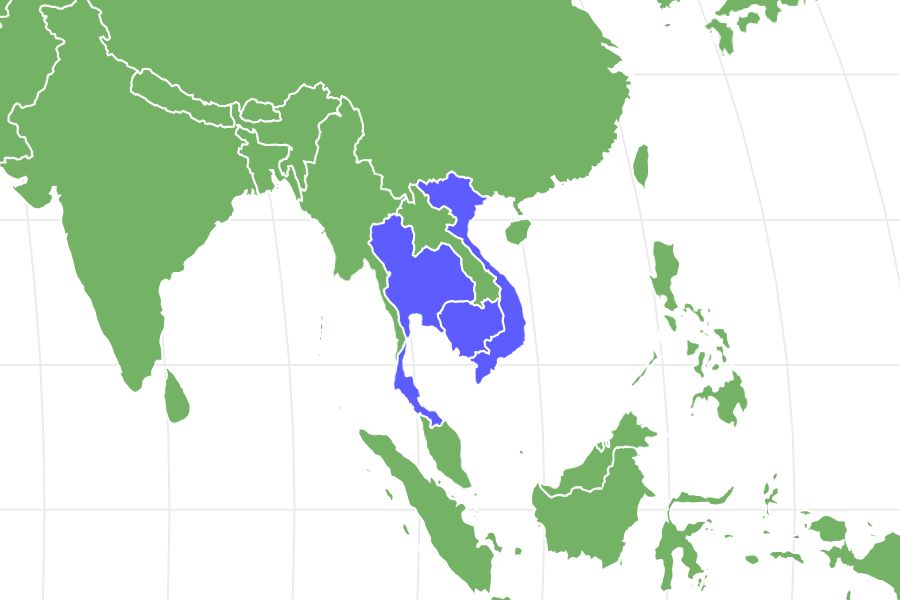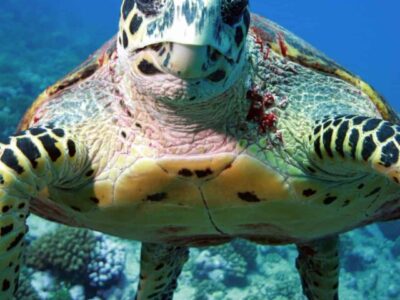Tentacled Snake
Erpeton tentaculatum
Their tentacles have nerves that attach directly into the area of the brain that processes visual information.
Advertisement
Tentacled Snake Scientific Classification
- Kingdom
- Animalia
- Phylum
- Chordata
- Class
- Reptilia
- Order
- Squamata
- Family
- Colubridae
- Genus
- Erpeton
- Scientific Name
- Erpeton tentaculatum
Read our Complete Guide to Classification of Animals.
Tentacled Snake Conservation Status
Tentacled Snake Facts
- Prey
- Fish, frogs, crabs
- Main Prey
- Fish
- Name Of Young
- Neonates
- Group Behavior
- Solitary
- Group
- Fun Fact
- Their tentacles have nerves that attach directly into the area of the brain that processes visual information.
- Biggest Threat
- Habitat destruction and poaching
- Most Distinctive Feature
- Tentacles on its head
- Litter Size
- 1-5
- Lifestyle
- Diurnal
- Favorite Food
- Fish
- Common Name
- Tentacled snake
- Number Of Species
- 1
- Location
- Cambodia, Vietnam, and Thailand
View all of the Tentacled Snake images!
Tentacled snakes are unique aquatic snakes that live in Peninsular Southeast Asia in Cambodia, Vietnam, and Thailand.
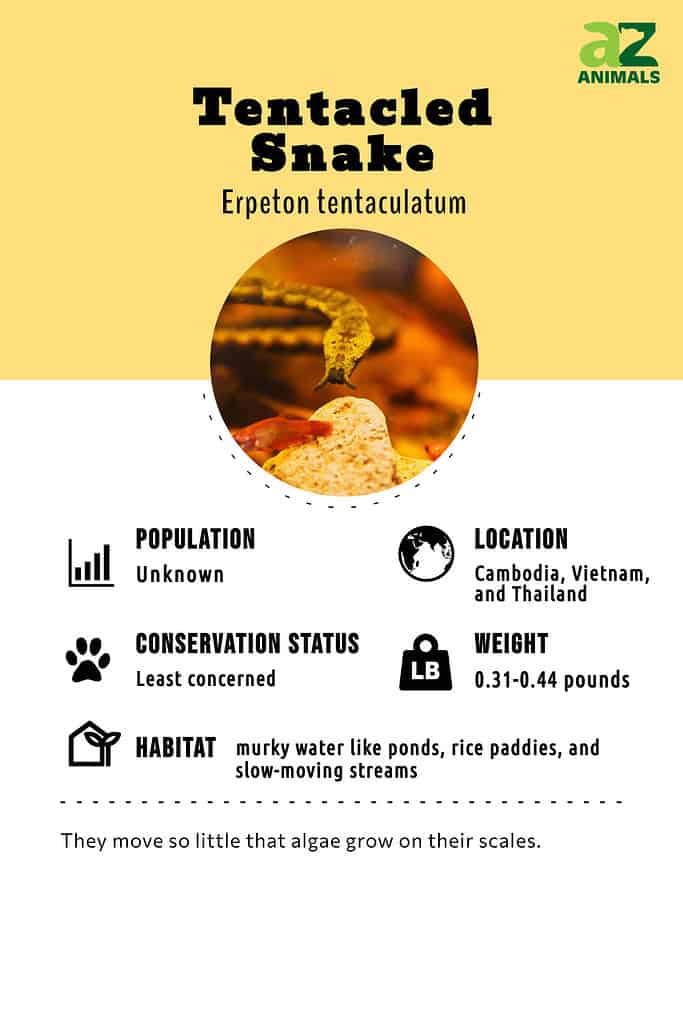
©
These small snakes are fish eaters that only rarely eat other creatures like frogs or softshell crabs. They may only come out of the water to burrow in the mud if the water they live in dries up too much.
Incredible Tentacled Snake Facts
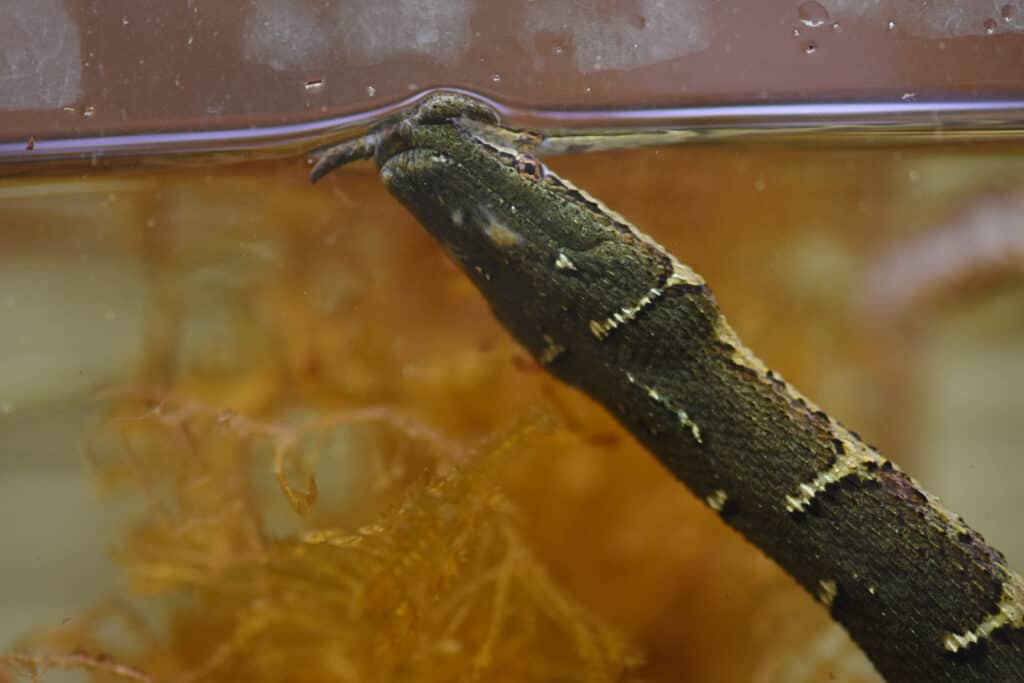
Tentacled snakes spend their entire lives in water and only come to the surface to breathe.
©Keung/Shutterstock.com
- The only snake to have tentacles coming out of the front of its head.
- It’s fully aquatic and spends its entire life in the water, and babies are born in the water.
- They move so little that algae grow on their scales. 90% of their time is spent not moving a muscle.
- Tentacled snakes can predict where their prey is going to be, and no one knows how.
Scientific Name and Classification
This snake is of the monotypic genus Erpeton in the Colubridae subfamily Homalopsidae. Their subfamily has about 50 species of Indo-Australian water snakes. Its scientific name is Erpeton tentaculatum, and specific name means tentacles.
Its common name of tentacled snake is appropriate and describes the unusual appendages on its head.
Appearance
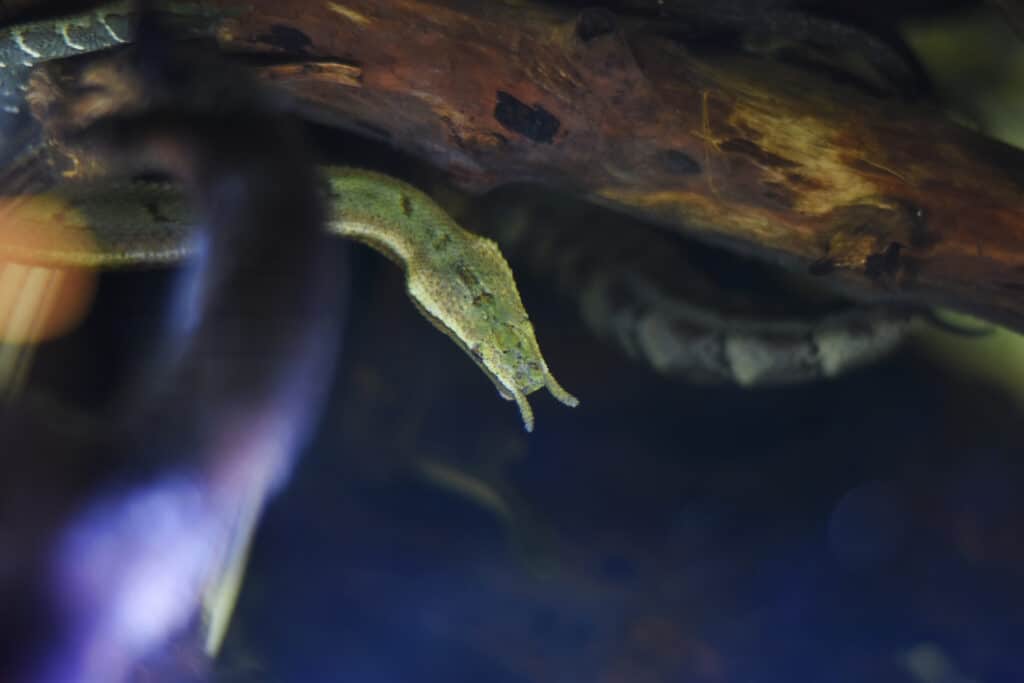
Tentacled water snakes are the only snakes with tentacles on their heads.
©Keung/Shutterstock.com
This small, completely aquatic snake is extremely flat with keeled scales. It typically measures 20-35 inches and has two phases: Striped or blotched. The base color can be dark gray, brown, or light tan. Like other snakes, they shed, but not many people seem to have witnessed it. It’s possible that the algae they grow on their scales are part of a symbiotic relationship, but that’s unclear.
The tentacled snake is appropriately named; two scaly appendages extend from the front of its head. It’s the only snake to have something like this. Not much is known for certain about the tentacles or their purpose. However, it’s likely that they have some use as a lure for prey, a camouflage tool, or helpful in locating prey. The tentacles have nerves that connect to the brain, where it receives and processes optic signals. So it is possible that they function as an extra sense to understand their environment. Additionally, its nostrils are placed on top of its head with valves that allow it to close the nostrils.
This species is mildly venomous and not considered dangerous to people. Its fangs are small and set very far back in its mouth and are only partially grooved. The venom is only dangerous to the fish it eats.
Behavior
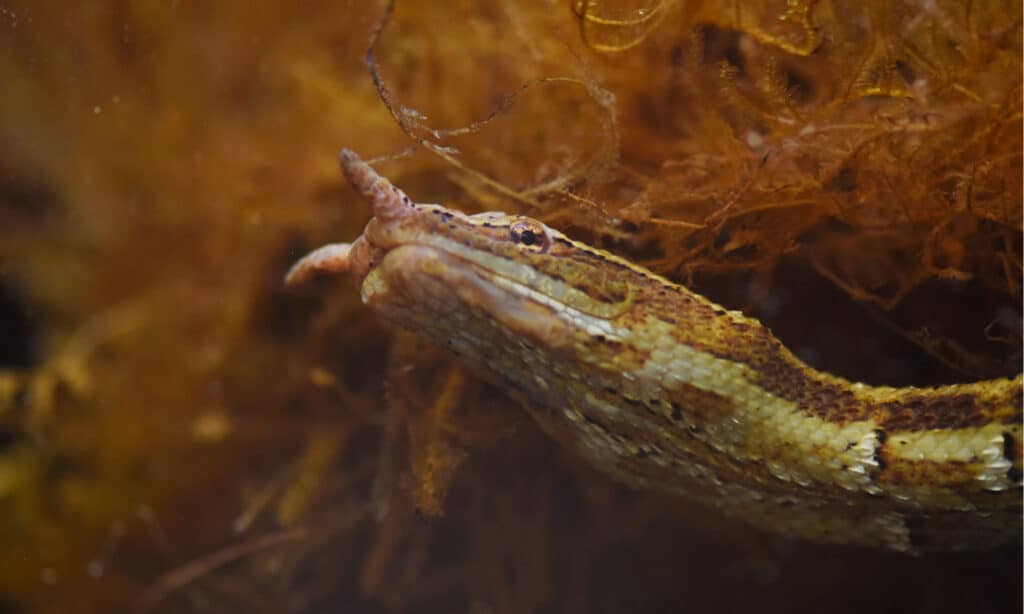
About 90% of the time, tentacled snakes don’t move a muscle, so they’re covered with algae.
©Keung/Shutterstock.com
Most of what we know about tentacled snakes’ behavior and life cycle comes from captive-bred individuals in zoos and private collections. There just isn’t much field research on them. These snakes spend their lives in water and can stay underwater for up to 30 minutes, pretending to be a stick.
Tentacled snakes have a unique hunting strategy. Technically, they’re ambush predators, but they manipulate the water around them to get prey to come to them. These snakes hang upside down in the water in a “J” shape, using their prehensile tails to hold their bodies steady. They herd prey by bumping out part of their body, which causes a wave and startles the fish. Their bump wave often makes it turn towards the snakes’ mouths.
The subject of scientific study, these snakes seem particularly skilled at predicting where the fish’s head will be and strike at that location instead of where it currently is. When they prepare to strike, they retract their eyes to protect themselves.
When threatened, tentacled snakes extend their bodies and do their best imitation of a stick. They even continue the act if you pick them up out of the water. It’s not quite as dramatic as the hognose’s display, but it’s still impressive.
This species is diurnal and sometimes burrows into the mud to rest at night. They also burrow during the dry season, but they’re awkward and slow on the land, so don’t spend much time there.
Habitat and Diet
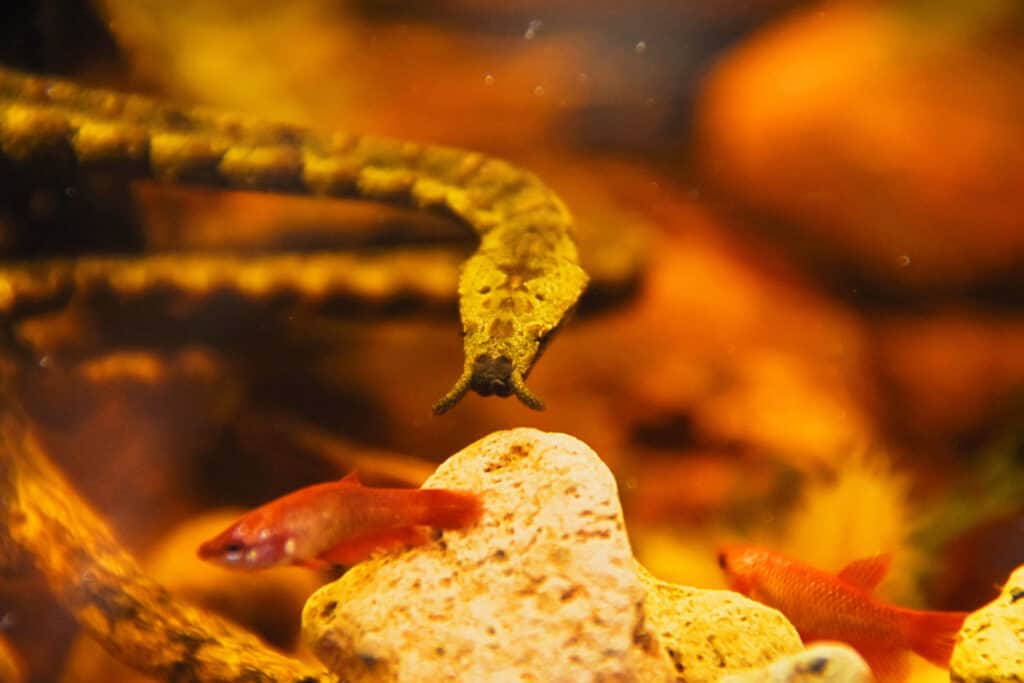
In zoos and aquariums, keepers generally feed goldfish to these snakes.
©Keung/Shutterstock.com
A tentacled snake lives its entire life in murky water like ponds, rice paddies, and slow-moving streams. It can live in fresh, brackish, or seawater and is endemic to Peninsular Southeast Asia in Thailand, Cambodia, and southern Vietnam.
A great example of where it likes to live is Tonle Sap lake in Central Cambodia. It has a lot of vegetation that sits at and below the water line, where it can do its stick impression.
This species almost exclusively eats fish; however, they’ve also been seen eating frogs and crabs. Young snakes eat only fish until they’re a little bigger. In zoos and collections, they’re typically fed goldfish.
Predators, Threats, Conservation, and Population
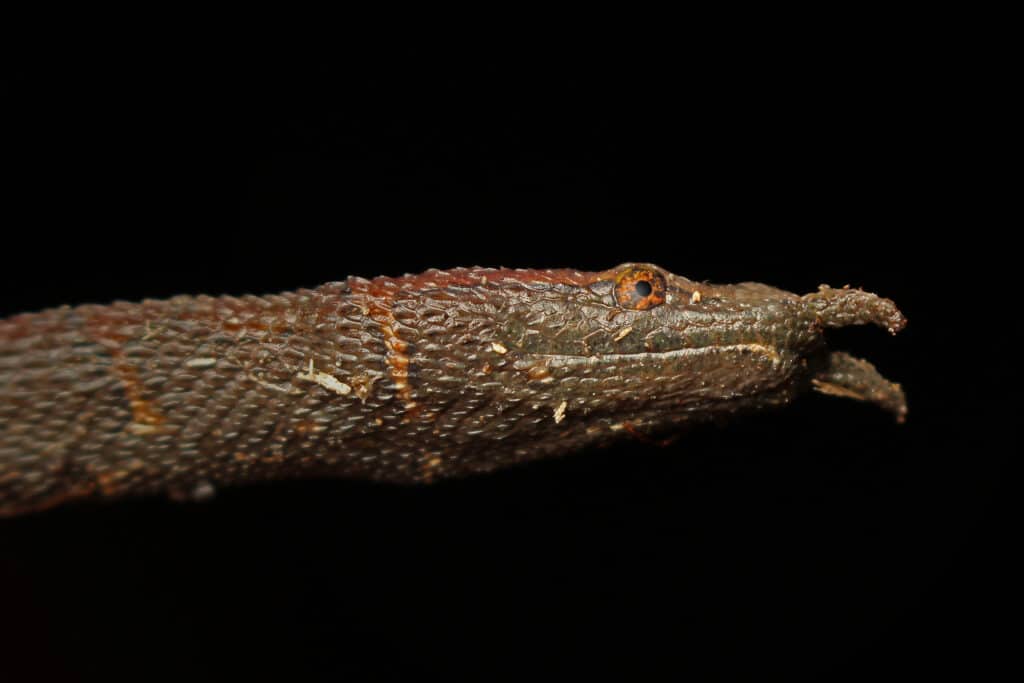
Tentacled Snakes are preyed upon by other predators and captured for the pet trade illegally.
©Davidsfeed/Shutterstock.com
According to the IUCN, the tentacled snake is common throughout its range and listed as a species of Least Concern. Although it’s harvested for food, those numbers are small and not likely to impact the global population. Their overall population isn’t known for certain, but they do seem to have a healthy population.
That’s not to say that it doesn’t have threats. Aquaculture in its native range is reducing its preferred habitat of murky water. It’s also preyed upon by other predators and captured for the pet trade illegally. However, there are some fungal diseases that affect reptiles that could become an even bigger problem than poaching and aquaculture.
Reproduction, Babies, and Lifespan
This species is reported to live about 10-20 years. They can make interesting pets, although they’re more of a display animal and require very specific living arrangements. Because they’re fully aquatic, it’s actually dangerous for them to be out of the water, so handling really needs to be limited.
They give birth to live babies, but scientists don’t know much about their mating habits in the wild, but they give birth to live babies. In keeping with this snake’s underwater lifestyle, their babies are born underwater. After several months of gestation, the females give birth to 1-5 live babies.
View all 133 animals that start with TTentacled Snake FAQs (Frequently Asked Questions)
Do tentacled snakes breathe under water?
No, they are reptiles with a lung that they need to fill with air. However, they only have to breed every 30 minutes or so.
Where do tentacled snakes live?
In the stagnant, murky waters of Peninsular Southeast Asia in Cambodia, Vietnam, and Thailand.
What do tentacled snakes eat?
Fish. These snakes are almost exclusively fish eaters. Sometimes they’ll frogs or crabs.
How do tentacled snakes hunt?
These unique snakes are ambush predators that hang upside down by their tails underwater. They bump at the fish to startle them into changing directions, and often that direction change leads the fish right to the snake’s mouth.
Thank you for reading! Have some feedback for us? Contact the AZ Animals editorial team.
Sources
- Murphy, J., Brooks, S.E. & Bain, R.H. 2010. Erpeton tentaculatum. The IUCN Red List of Threatened Species 2010: e.T176697A7285596. https://dx.doi.org/10.2305/IUCN.UK.2010-4.RLTS.T176697A7285596.en. / Published February 15, 2009 / Accessed August 11, 2022
- Tentacled snake | Smithsonian's National Zoo & Conservation Biology Institute / Accessed August 11, 2022
- Erpeton tentaculatum | Reptarium Reptile Database / Accessed August 11, 2022

